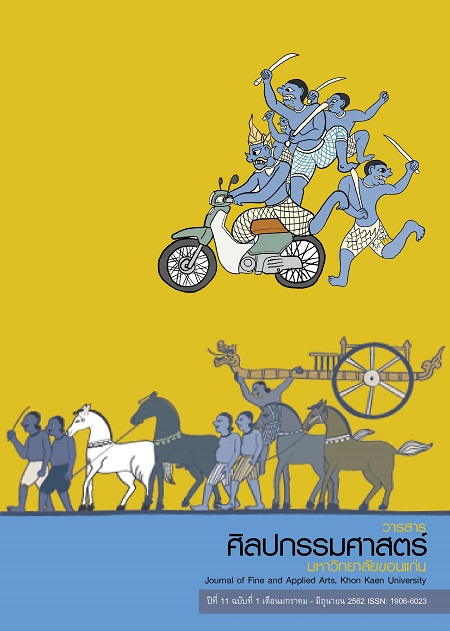A Comparative analysis of Scott Lafaro’s and Marc Johnson’s Improvisation on Miles Davis’s Nardis
Main Article Content
Abstract
This analysis, focused on a comparative of Scott Lafaro’s and Marc Johnson’s improvisation on Nardis composed by Miles Davis. Researcher focused on Rhythm, Melodic Structure, Harmony, Scales Bass Technic and others musical element. From an analysis, found that both bassists use varieties of rhythmic to develop their phasing, mostly on Eight-Note and Triplet. to develop their motifs, they create a Polyrhythm and Rhythmic Displacement to expand more possible ways to improvise. Scott Lafaro uses patterns of rhythmic scales and arpeggio with a chord changes to make his improvisation line to be linear pattern while Marc Johnson use the same element but focused more on intervals. In part of harmony, both bassists use varieties of scales to be a source of their improvisation which can create an Expansion on an improvisation’s line. On bass’s Technic, both bassists use a Harmonic Technic to color their lines. Marc Johnson have more variation on Technic Than Scott Lafaro moreover, Ornamenting variation from a melody also found on Marc 's improvisation line.
Article Details
Content and information in articles published in the Journal of Fine and Applied Arts of Khon Kaen University is regarded as the opinion and sole responsibility of the author(s) directly; therefore, editors are not obliged to agree to or share any responsibility with regard to the content and information that appears within these articles.
All articles, information, content, image, etc. that have been published in the Journal of Fine and Applied Arts of Khon Kaen University is the copyright of the Journal of Fine and Appllied Arts of Khon Kaen University. Any person or organization who wishes to distribute all or parts of the articles for further dissemination or other usage must first receive permission from the Journal of Fine and Applied Arts of Khon Kaen University before proceeding to do so.
References
ณัชชา พันธุ์เจริญ. (2552). พจนานุกรมศัพท์ดุริยางค์ศิลป์. กรุงเทพฯ : สำนักพิมพ์เกศ กะรัต.
เด่น อยู่ประเสริฐ. (2553). เอกสารการสอนเรื่องดนตรีแจ๊สและการวิเคราะห์. ปทุมธานี: สำนักพิมพ์มหาวิทยาลัยรังสิต.
ธีรวัฒน์ ตันบุตร. (2561). “การวิเคราะห์แนวบรรเลงเดี่ยวดับเบิ้ลเบสของ รูฟัส รีดในบทเพลงบอดีแอนด์โซล” วารสารดนตรีรังสิต ปีที่13, ฉบับที่ 1 (มกราคม) : 91-104.
นพดล ถิรธราดล. (2554). วิเคราะห์เปรียบเทียบแนวการเดินเบส และการด้นเบสในดนตรีแจ๊ส ของชาร์ล มิงกัส เรย์ บราวน์ และเอ็ดดี้ โกเมส. วิทยานิพนธ์ ศศ.ม. สาขาวิชาดนตรี มหาวิทยาลัยมหิดล.
รุ่งธรรม ธรรมการ. (2557). เทคนิคการบรรเลงทรอมโบนของ วายคลิฟ กอร์ดอน ในบทเพลงเชอโรกี. วิทยานิพนธ์ ศศ.ม. สาขาวิชาดนตรี มหาวิทยาลัยรังสิต.
ศักดิ์ศรี วงศ์ธราดล. (2555) ทฤษฎีดนตรีแจ๊ส เล่ม 1. กรุงเทพฯ : วงศ์สว่างพับลิชชิ่ง แอนด์ พริ้นติ้ง.
อนันต์ ลือประดิษฐ์. (2545). แจ๊สอิสระภาพทางดนตรีของมนุษยชาติ. กรุงเทพฯ : เนชั่นมัลติมีเดีย กรุ๊ป.
Clark, R. (2014). An Analysis of The Bass Playing of Scott Lafaro as Part of The Bill Evans Trio 1959-1961. Master of Music Massey University.
Helsley, J. D. (2016). The Evolution of The Improvisational Vocabulary of Marc Johnson. Doctor of Musical Arts University of North Texas.
Noble, L., Baron, C., Evans, B., Johnson, M., & Labarbera, J. (2003). The Bill Evans Trio Volume 1 (1959-1961). Milwaukee, WI : Hal Leonard.


